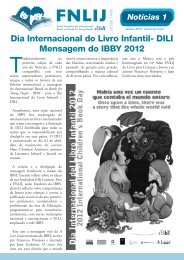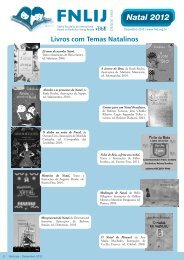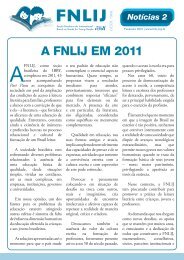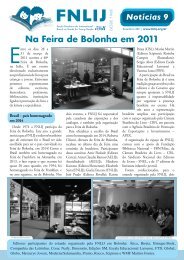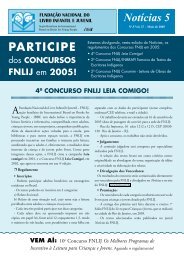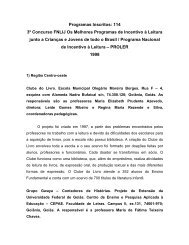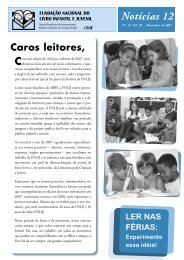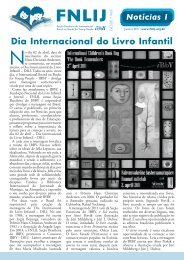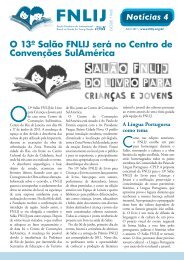Selection - FNLIJ
Selection - FNLIJ
Selection - FNLIJ
You also want an ePaper? Increase the reach of your titles
YUMPU automatically turns print PDFs into web optimized ePapers that Google loves.
14<br />
Flicts<br />
In 1969, writer and illustrator Ziraldo writes, as invited by<br />
Expressão Cultural publishing house, the history of Flicts.<br />
This work is differentiated by modern, daring graphic design,<br />
and thus becomes a milestone for children’s literature in<br />
Brazil. Flicts tells the story of a color that could not find its<br />
place on earth. In the midst of solitude, the character decides<br />
to flee and ends up on the moon, where it finds a satellite<br />
of its own color. The story has just been put into a Japanese<br />
version by the Ofusha publishers.<br />
Vânia Maria Resende, an educator holding a São Paulo<br />
University PhD degree on Comparative Studies of Literatures<br />
in the Portuguese Language, has underlined that Ziraldo’s<br />
book release was an important moment in children’s and<br />
youth literature in the country as it brought together<br />
elements that were not limited to the classical notion of<br />
literature but rather included multiple visual contexts, in<br />
addition to the linguistic sense. “Flicts is the result of a<br />
new concept of book/literature, where the visual aspect is<br />
highlighted and new avenues are open to readers. This is what<br />
we classify as simultaneist literature,” Vânia Maria explains.<br />
In the wake of Flicts, a more professional view of illustrators<br />
came into existence and publishers started to take an interest<br />
in books as works of art. “To make it to the market, Flicts<br />
relied on the support from a revolutionary publisher who<br />
decided to launch a book of exceptional visual and graphic<br />
quality,” she said. Vânia also underlined the importance of<br />
the verbal-graphic-visual style that was started with that book:<br />
“The breadth of Ziraldo’s language mixes visual and verbal<br />
aspects and takes on a universal symbolic dimension which<br />
allows for different reading perspectives. Ziraldo draws as he<br />
writes and writes as he draws.”<br />
Elements of transformation and overcoming can be found in<br />
there that will facilitate reading the social context in which<br />
the book was written: “During the military dictatorship, Flicts<br />
would have represented the struggle between luminosity and<br />
obscurantism. The special color fought to be relieved from<br />
the oppression by the other colors,” she analyses.<br />
Flicts<br />
Melhoramentos.<br />
ISBN 9788506059241<br />
O menino maluquinho<br />
Melhoramentos.<br />
ISBN 9788506055106<br />
Menina Nina<br />
Melhoramentos.<br />
ISBN 9788506053942



